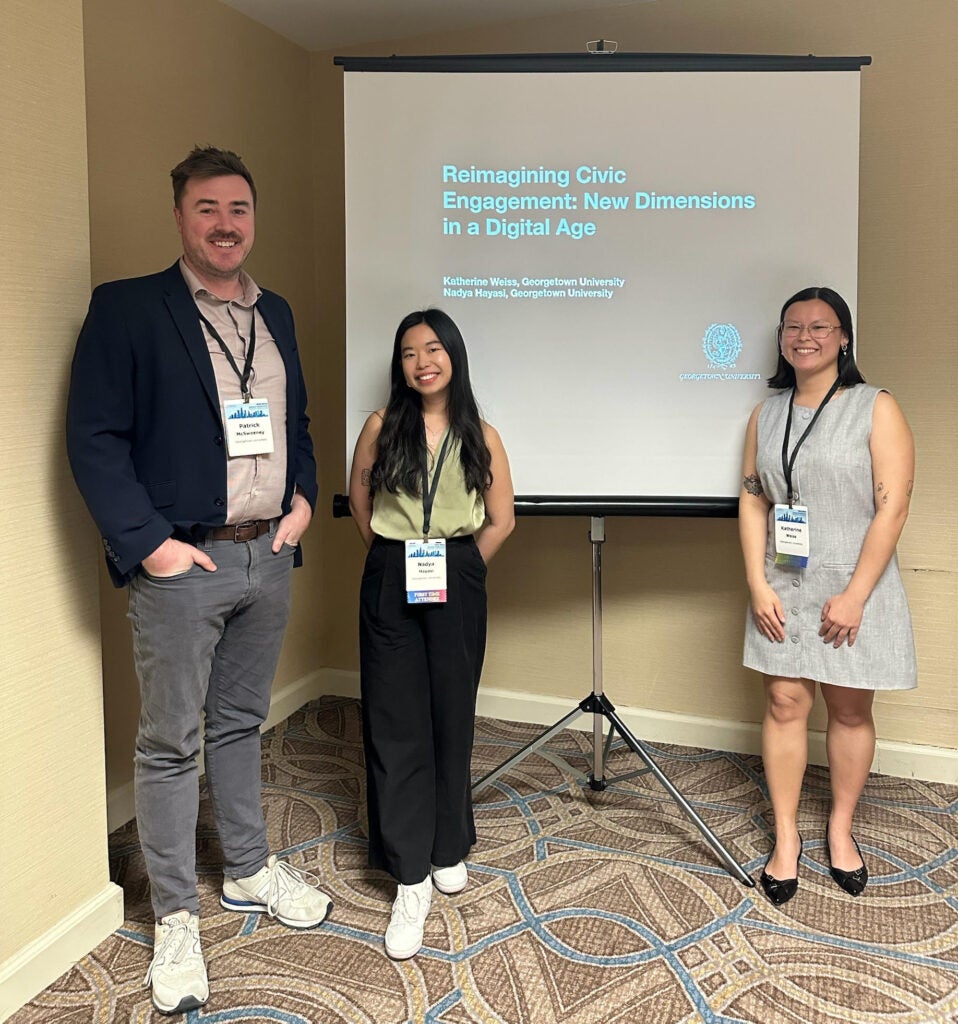CERL Presents Research to Midwest Political Science Association in Chicago
Posted in News
What Does It Mean to Be an Engaged Citizen in a Digital World?
CERL Associates Katherine Weiss and Nadya Hayasi presented their paper, “Reimagining Civic Engagement: New Dimensions in a Digital Age” at the annual meeting of the Midwest Political Science Association. Their research examines how individuals from different demographic and identity groups defined civic engagement during the 2024 election cycle, highlighting the impact of increased opportunity for digital political participation on these perceptions.

Drawing on an original national survey of nearly 1,900 eligible voters, their study investigated whether digital activities like reposting political content, donating online, or organizing virtual events are seen as legitimate forms of civic engagement. The findings provide insights into how different demographic groups define and approach civic engagement, and how these definitions may shift due to ongoing changes in political discourse and technology. The study was designed by the Media and American Elections graduate seminar and sponsored by the Civic Education Research Lab.
As technology continues to evolve, so must our understanding of what it means to be an engaged citizen. This research opens the door to broader, more inclusive definitions of civic life in a digital democracy.
Key Insights
Identity Matters: People of color, lower-income individuals, and those with strong partisan identities are more likely to view digital actions, especially low- and medium-effort ones, as valid civic engagement.
Digital Divide by Partisanship: Democrats are significantly more accepting of digital civic engagement than Republicans, especially in medium-effort activities like hashtag activism or sharing political content.
Effort Counts: High-effort digital activities (e.g., organizing events, donating) are broadly recognized across demographic groups, likely due to their similarity to traditional offline participation.
Younger ≠ Always More Engaged: While younger people are somewhat more open to digital forms, the differences aren’t as large as expected, especially for low- and high-effort actions, which see fairly universal responses.
Is the Democratic Party Leaving Young Activists at the Kids’ Table?
CERL Research Specialist Patrick McSweeney presented his paper “The Youth Agenda: Activism, Priorities, and Democratic Party Politics in 2024”. The project explores the complicated relationship between the Democratic Party and youth-led activist organizations—groups that bring energy and ideas to the coalition, but also introduce risk for a party trying to appeal to a broad, and often cautious, electorate.
Ahead of the 2024 election, several youth organizations came together to release the Youth Agenda, a bold policy roadmap built around climate justice, immigration reform, gun control, reproductive rights, and economic fairness. These demands reflected both the diversity and urgency of youth political engagement, grounded in the generational traumas and formative experiences of the current cohort of young people.
While many of these priorities, like reproductive rights and gun reform, aligned with Democratic messaging, others introduced tension. Demands for limits to policing or stricter immigration enforcement, for example, risked alienating swing voters and independents in battleground states. Republican messaging actively sought to make youth activists the face of the Democratic Party, using protest rhetoric and polarizing demands to paint the party as out of touch with mainstream America.
Faced with this, Democratic leaders were incentivized to create distance—what I describe as leaving youth activists at the “kids’ table” of the party. They were welcomed for turnout operations and social media reach, but rarely brought into real policy conversations. Using survey data from the Cooperative Election Study and the American National Election Study, I identify issue areas where young Democrats diverged most from older partisans, and explore how those cleavages played out across the Biden and Harris campaigns. While Harris’s candidacy created new energy among young voters, conflict over climate, Gaza, and immigration remained.
This strategic distancing highlights a core dilemma: the Democratic Party relies on young people to win elections, but hesitates to fully embrace their demands for fear of losing moderates. Youth activists, meanwhile, face the challenge of staying engaged with a party that often sees them as both an asset and a liability.
This paper builds on Patrick’s dissertation and connects to our work at CERL where we help young people gain the tools to be civically engaged.
